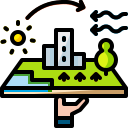Green Infrastructure and Urban Resilience
Green infrastructure is an innovative concept that integrates natural elements into urban environments to promote sustainability, enhance environmental quality, and build resilience in the face of climate challenges. By weaving nature-based solutions into the cityscape, green infrastructure offers numerous social, economic, and ecological benefits, transforming urban areas into healthier and more adaptive spaces for people and wildlife. Urban resilience, closely linked to green infrastructure, refers to a city’s ability to anticipate, prepare for, respond to, and recover from adverse events—whether environmental, social, or economic. This page explores the vital relationship between green infrastructure and urban resilience, demonstrating how these approaches are shaping the cities of tomorrow.
Urban Resilience: Defining the Framework
Anticipating Climate Risks
Building Social and Environmental Capacity
Flexible and Adaptive Urban Systems
Permeable Surfaces and Urban Hydrology
The Role of Urban Wetlands
Green Roofs and Rain Gardens
Cooling Cities and Combating Urban Heat
Increasing Tree Canopy and Shade
Green Roofs and Vertical Gardens for Cooling
Urban Parks and Pocket Green Spaces

Enhancing Urban Biodiversity and Wildlife Habitat
Social Benefits of Green Urban Spaces
Physical and Mental Health Improvements
Fostering Social Connections and Inclusion
Educational and Stewardship Opportunities
Economic Advantages of Green Infrastructure

Policy, Planning, and Implementation Strategies

